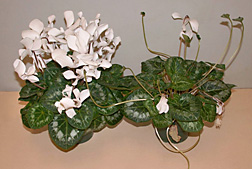This page has been archived and is being provided for reference purposes only. The page is no longer being updated, and therefore, links on the page may be invalid.
|
Read the magazine story to find out more. |
|
|
|
|
Longer-Lasting Flowers: Fresh Ideas From ARS Researchers
By Marcia WoodApril 2, 2010
Tomorrow's fragrant bouquets and colorful potted plants might last longer, thanks to floriculture research by Agricultural Research Service (ARS) plant physiologist Cai-Zhong Jiang. His investigations might help boost the vase life of favorite cut flowers and shelf life of prized potted plants.
Jiang is with the ARS Crops Pathology and Genetics Research Unit at Davis, Calif. He's collaborating with researchers from the University of California-Davis (UCD) and elsewhere.
In ongoing studies, Jiang, UCD colleague Michael S. Reid and co-researchers have shown that spraying low concentrations of a compound known as thidiazuron (TDZ) has significant, sometimes spectacular effects in extending the life of potted plants' leaves and flowers. For example, in tests with greenhouse-grown cyclamen plants, TDZ-treated plants had a significantly longer life than did unsprayed plants, according to Jiang. Leaves of TDZ-treated cyclamen plants took longer to yellow and fall off than those of untreated plants.
TDZ, a synthetic version of a naturally occurring plant compound known as a cytokinin, is not new. But preliminary studies with cut flowers, reported by Reid and co-researchers in 2000, were the first to demonstrate the value of TDZ for a commercial floricultural species—in that case, alstroemeria. The cyclamen experiments conducted by Jiang and collaborators are the first to show the leaf-saving and blossom-boosting effects of TDZ with potted floricultural plants.
Jiang and colleagues reported some of their TDZ findings in Postharvest Biology and Technology earlier this year, and in Acta Horticulturae in 2009.
Though commercial use of TDZ on cut flowers and potted plants seems promising, the researchers' deeper interest lies in determining precisely how TDZ affects genes and proteins inside the plants.
Read more about this research in the April 2010 issue of Agricultural Research magazine.
ARS is the U.S. Department of Agriculture's principal intramural scientific research agency

